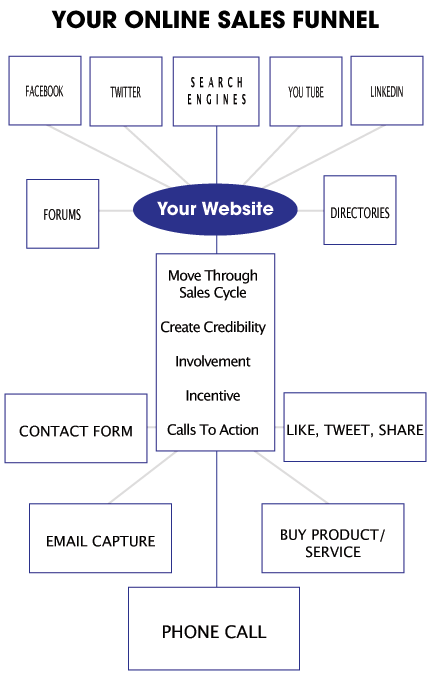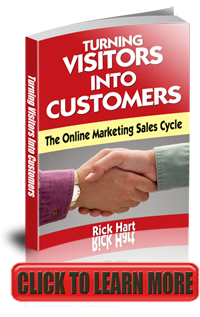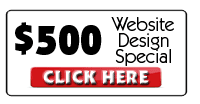Your Most Wanted Responses
 There’s certain actions you would like your visitor’s to take when you meet them at a Touchpoint. That could be Facebook, Google, YouTube, offline, your website, or really any place you might meet them. These are your Most Wanted Responses. Often, today, these actions are called Key Performance Indicators or KPIs. MWRs and KPIs are really the same thing with differences relating to specific goals of a campaign.
There’s certain actions you would like your visitor’s to take when you meet them at a Touchpoint. That could be Facebook, Google, YouTube, offline, your website, or really any place you might meet them. These are your Most Wanted Responses. Often, today, these actions are called Key Performance Indicators or KPIs. MWRs and KPIs are really the same thing with differences relating to specific goals of a campaign.
Of course, ultimately you want them to give you a call or buy your product, but there’s a series of intermediate MWR’s that you would like to see happen.
These intermediate MWRs help you know if you are engaging your visitors and actually moving them through your sales funnel effectively. Combined with your tracking tools, watching these intermediate MWRs will tell you what’s working and what’s not.
There’s really a series of MWRs, depending on where you are meeting them…
Off Your Website
Off your website there really is only one goal… GET THE CLICK.
A hyperlink click it really the only action that indicates that someone you meet is ready to enter your Sales Funnel. That click indicates they like what they see and want to go to the next step. That click qualifies them as someone who might be interested in your offer, and turns them from a suspect into a prospect.
Many people make the mistake of thinking just a picture or some text with no link is effective. I don’t think it is. Without that implied Call To Action, there really is no way to know if your post, comment, image or article worked. Once something is clicked, it becomes trackable and then you can see whether it worked or not, especially if you use UTM parameters on that link. UTM parameters are tracking code that you can add to any link. More about that here.
Where Should That Click Go?
Where that click goes is very important. Any time you offer a click, there’s an implied indication that there’s something useful at the other end of the click. If you don’t make sure that that click delivers, then you could be losing a prospect very quickly… and perhaps hurting your credibility.
The image, text or story, should create curiosity and interest but then deliver what it promises on the other end of that click. If you can do that, then you may get someone to enter your sales funnel and now you can start to build a relationship with the rest of your marketing.
Of course the best place to send them is your website.
Your website is the hub of all your marketing. It’s the one place online where you have complete control of your message. All the other touchpoints are owned and controlled by someone else. They may giveth, for a while, but they are just as likely to taketh away later on.
Your website is the place where someone can move through your Sales Cycle and take the actions that really can mean something to you—like signup for your email system or maybe even buy something.
The Facebook Mistake – Interruption versus Interaction
I often see posts on Facebook with no links. The posts are text, pictures or even videos with no implied call to action. Those posts might as well be a newspaper ad, or a billboard, that you have no way of knowing whether it works. Those types of ads interrupt people without letting them interact with your post. There’s no benefit to them or you.
Interaction is the Key
The big advantage of Digital Marketing, when done right, is it let’s people interact with your marketing. They start clicking and following your funnel, and before long they think it was all their idea. They think they have control. There’s no other marketing that offers this kind of engagement.
So, bottom line, when you meet someone at any touchpoint, do your best to get them to your website as quickly as possible.

Digital Marketing Sales Funnel
On Your Website
1. You’d Like Your Visitors To Stay
One of the first things you’ll notice in your Google Analytics data is how quickly people leave your site. This is called your Bounce Rate. This metric tells you the percentage of people who leave your site from the first page they land on.
It can be disconcerting to see that 60-70% of your visitors never make it past the first page they see. They never really even get into your sales funnel at all.
Some of the reasons people might not stick around…
- The site design is unprofessional
- The page they landed on really doesn’t answer the question the link implied
- They can’t find “what’s in it for them” quickly enough
- Your site is overwhelming or too “salesy”
- They got there by accident or mistake (mis-clicked)
 2. You’d Like Your Visitors To Read Your Content
2. You’d Like Your Visitors To Read Your Content
Until someone starts reading (or watching) your content you can’t move them through your sales cycle. Your words are your tool for creating credibility for you and your solution. If they don’t read, you don’t sell.
Google Analytics data like Pages Per Visit, and Time On Site can give you a sense of whether people are reading your content or not.
Text Formatting Is Key
Website owners often make the mistake of formatting their content as if someone was reading a book. The web is different. People aren’t as committed to reading as when they buy a book or magazine. Plus it’s just harder to read online on a computer screen.
Often people want to decide if your content is worth reading before they commit. They skim headlines and subheads and bulleted lists first to see “what’s in it for them.”
The key to getting them to read is to format your pages in a very easy-to-read way using…
- short sentences
- short paragraphs
- lots of headlines and subheads
- bulleted lists
- bolding of key phrases and concepts
- graphics and pictures to hold readers attention
Don’t forget videos. More and more people like to see videos on a website. It’s a higher quality communication and very engaging for most visitors. It will keep your visitors on your site longer and get them to know you more quickly.
The classic communication axiom is…
“The more senses you can get your audience to use the more effective the communication.”
3. You Want Your Visitors To Go To The Right Pages
Certain pages on your site indicate buying intention, or at least that visitors are truly interested in your value proposition. Depending on your business, certain pages will also indicate that people are moving down your funnel and getting closer to making a decision about you. Certainly a sales page, product page, or contact page are great examples of pages at the end of the funnel.
Be sure to monitor these pages with your Google Analytics tracking so you can see if you’re getting the results you want. You can also create Goals in Google Analytics that show specifically that people are reaching these pages and how they arrived there.
4. You Want Your Visitors To Trust You
Until your visitors like and trust you they won’t be taking many of your recommendations. This is sometimes called PREselling but I prefer to call it just creating credibility.
It’s much like when you first meet someone. Until you find common ground and shared interests, there really is no basis for a friendship or trust.
And without some degree of trust they won’t be sticking around long.
Here’s a couple of key strategies for getting your visitors to trust you…
- Put your picture on your site (even better a video)
- Tell your back-story in a personal way (no bragging)
- Share your passion for the subject that you have in common with your visitors. This is what I call the Common Emotional Context. It’s what you both care about.
- Share how your “solution” changed your life (again personal with no selling)
- Share testimonials from other people about you
- Share testimonials about your solution from other people
 5. You Want Your Visitors To Engage
5. You Want Your Visitors To Engage
Now this sounds vague and hard to measure, but if you’ve taken care of 1-3 you should be able to ask for something that shows they are engaged in your sales funnel. I call this the “Involvement” stage of the sales cycle. This is where they “need” to know more and get committed to finding a solution (hopefully yours).
A good test is to ask them to sign up for your email list, newsletter or free gift. If they respond then you’ve moved them at least part way through your sales cycle.
Another good test for your sales funnel is getting Facebook “likes” from your visitors. When they are willing to share your content with their Facebook friends, it’s not only a vote for you, but a chance to virally spread your sales funnel to their friends.
Note: If you are not familiar with how Facebook works… when someone clicks on a “like” button it means a post will be added to your visitor’s Facebook page (not yours). That post should have a link to your website, sometimes with a picture, or a few phrases from your web page. This is a very cool and powerful link to your site.
Of course, now we have buttons for Google+, LinkedIn, YouTube and lots of other Web 2.0 sites. These buttons should all be on your website. They create viral marketing links and help you by spreading your message.
6. Don’t Forget To Ask For The Order
Here’s a phrase that I remember from my sales training days…
“A good salesperson is always qualifying/closing their prospect.”
What this means to an online marketer is… you should always be asking questions, via a link, that leads to a higher stage in the sales cycle. Something like…
“Are you ready to learn how the Taylor Made R11 driver can add 20 yards to your drive? Click here.”
“Want to see how the Ultimate Stress Relief Toolkit can lower your stress level? Click here.”
“Click here to get my free ebook on How To Understand The Online Marketing Sales Cycle.”
If someone clicks on any of these links it means they’ve qualified themselves as someone who wants the benefit implied in the question. You can now treat them entirely differently than a typical site visitor. You can now sell to them. But only the right way.
Notice what all these questions have in common…
They all talk about the BENEFIT of clicking. Remember, people are only motivated by What’s In It For Them (WIFT). Your language must always be benefit driven to hold their attention and get them to take an action.
That is key.
You’ve just moved someone from suspect to prospect. Before they clicked on your link you didn’t know if that visitor was just looking for free information (what I call a tire-clicker) or was really ready to solve their problem. Now you know!
And if that link led to an email signup, now you know you have someone on your email list that has a genuine interest in your solution. This is one reason why you might want to have multiple email lists that segment your visitors/prospects into varying levels of readiness to buy.
If that link (and question) leads to your sales page, then you know they probably are seriously interested in solving their problem.
So a good online marketer is always moving people to a higher stage in the sales cycle.
Actually, a better way to say it is…
You should always be giving your visitors the opportunity to buy… when they are ready.
But it needs to be their idea and not yours. You are not selling. You are merely the “solution provider” that facilitates the process.
Remember… “People hate to be sold, but they love to buy.” Let them buy.
7. On The Sales Page
OK now you have qualified prospects that you’ve moved from your PREselling pages to your sales page. You’ve almost achieved your “Most, Most Wanted Response.” What do you do now?
The last thing you want to do is lose someone once they’ve gotten this far. You must be careful not to…
- Overwhelm them with too much information or too many choices
- Move them backwards in the sales cycle
- Give them a reason to change their mind
If they are truly not ready to buy then they can move backwards on their own until they are ready. They’ll figure it out.
All you want to do on your Sales Page is…
1. Remind them of the pain they are experiencing because of their problem
2. Remind them how they will feel once they solve their problem
3. Remind them why your solution is the best
4. Give them an incentive and/or guarantee
5. Ask for the order
This should all be done very quickly and without a lot of content. Maximum page size 300-500 words. Everything has already been said. Don’t get them confused. If they aren’t ready they will leave. Don’t help them.
Now if you are really a sophisticated marketer, you can set up dynamic ways to upsell, downsell, and sidesell your prospects, either after they buy, or if they try to leave the page. We won’t go into those options now. Just be aware that those tactics do exist and are available.



